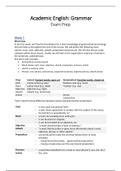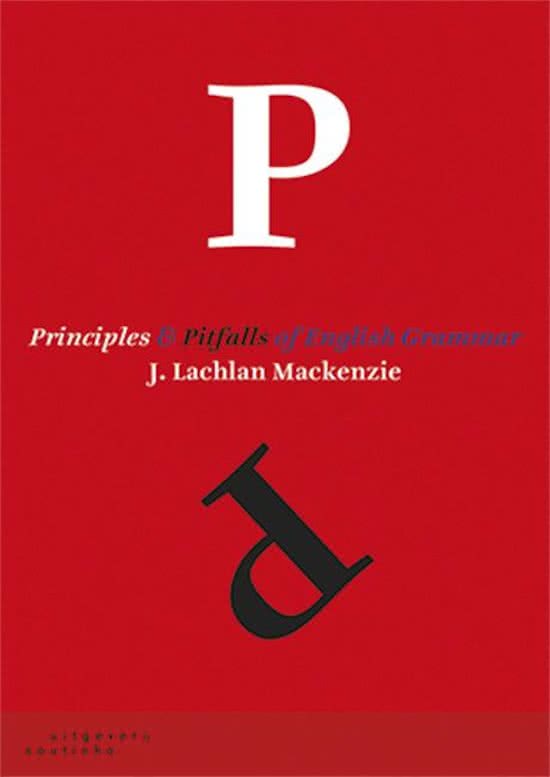Academic English: Grammar
Exam Prep
Week 1
Word class
In the first week, we’ll lay the foundations for a basic knowledge of grammatical terminology
that will help us throughout the rest of the course. We will define the following word
classes: noun, verb, adjective, adverb, preposition and pronoun. We will also discuss some
subtypes within these classes. Finally, we will look at the organization of groups of words in
the sentences, called phrases.
Key terms and concepts:
• Grammatical vs lexical words
• Word classes: verb, noun, adjective, adverb, preposition, pronoun, article
• Lexical vs auxiliary verbs
• Phrases: noun phrase, verb phrase, prepositional phrase, adjective phrase, adverb phrase
Class Lexical: Content words; open set Grammatical: Function words; closed set
Verb Lexical verb (e.g. pay) Auxiliary verb (e.g. must)
Noun Lexical noun (e.g. table) Pronoun (e.g. she)
Adjective Adjective (e.g. high) -
Adverb Adverb (e.g. tomorrow) -
Article - Article
Conjunction
*don't need to know difference between lexical and grammatical prepositions
Verb − it has a past and present form,
− a verb shows agreement in number with the subject of the clause,
− the full form is preceded by ‘to’
Noun − a noun can (usually) occur with a/an,
− it can be plural or singular,
− it can be preceded by an adjective, etc.
Adjective − “a word that describes a noun or pronoun.”
Adverb − “a word that describes or gives more information about a verb,
adjective, phrase, or other adverb.”
Preposition − are words which relate the unit that follows them to what
precedes.
− ... being fond of chocolate. [grammatical preposition]
− ... having a lovely view over the sea. [lexical preposition]
Pronoun − a word that substitutes for a noun or noun phrase (I, you, she, etc.)
Article − the, a/an
, Exam Prep Academic English: Grammar | Kimberly van den Ouden
Noun phrase • Noun phrase = single noun + associated words
• Associated words can be: articles, adjectives, prepositional
phrases
• Noun phrase can be replaced as a whole by a pronoun
Verb phrase • all verb forms in one clause = lexical verb + possible
auxiliaries
e.g. He may have been sleeping / has slept / was sleeping
Prepositional e.g. without his book / on the road / in 1995 / in Paris
phrase
Adjective phrase e.g. very big / highly intelligent
Adverb phrase
P&P Ch. 2
2.2.1
Most verbs have four forms. The grammatical verb be has the most (8: be, am, are, is, was,
were, been, being). Whereas the lexical verb hit has 3 (hit, hits, hitting) and must only 1.
Lexical verbs play an important role in language, identifiying what kind of state of
affairs we are talking about. Other words group around the lexical verb, forming a clause. A
sentence can consist of one clause or more. Each clause has a meaning, and the meaning of
a sentence is a composite of the meanings of the clauses that make it up.
2.2.2
The importance of the verb is reflected in the fact that it marks four gramatically vital
contrasts, namely tense, aspect, voice and mood.
Aspect is concerned with how you view the state of affairs you are talking about ;
duration. Limited duration = progressive aspect = add -ing suffix
Otherwise = simple aspect = absence of -ing suffix
Voice is a matter of your point of departure in presenting a state of affairs --> act. or
passive.
The dog bit the man [active voice]
The man was bitten [passive voice]
The passive voice adds a different suffic to the verb (bite-->bitten)
Mood reflects the role that the clause plays in communication. The indicative mood
is found in statements and questions. The other two moods: the imperative and the
subjunctive mood, are recognizable by their form, which in both cases is always just the
plain form of the verb. The imperative mood is used in orders and requests. The subjunctive
mood, once used to express wishes, now only survives in fixed expressions like God save the
Queen or Praise be to the Lord, or, above all, in American usage, after sequences comprising
a verb of desiring + that.
Johny wisely left the dog alone [indicative mood]
Leave that dog alone, Johny. [imperative mood]
I insisted that he leave the dog alone [subjunctive mood]
2.2.3
A full clause will always contain at least one verb, and can have many more. The totality of
verbs in a clause is called the verb phrase. The last or possibly only verb in the sequence is
always the lexical verb; all others are grammatical verbs. Grammatical verbs are known as
, Exam Prep Academic English: Grammar | Kimberly van den Ouden
auxiliary verbs or auxiliaries. Auxiliaries occur in a fixed order: the sequence may have been
being cannot be shuffled around.
2.2.4
Auxiliaries have a number of unusual properties that distinguish them from lexical verbs.
They are known as NICE properties: Negation, Initial, Code and Emphasis. With all four NICE
properties, it is always the first auxiliary verb (= an operator) that is involved. It is always the
verb do that is inserted if an operator is needed. It has no meaning here, just a supportive
function, it is known as a dummy operator or (as Abby says): a dummy do.
If a clause contains at least one auxiliary verb, then it is negated by placing not or n't
immediately after the first auxiliary verb in the sequence. If there is no auxiliary in the non-
negated clause, negation involves a form of the auxiliary do. This also counts for the lexical
verb of pay.
If a clause contains at least one auxiliary verb, then it is questioned by positioning the
first auxiliary in the initial position of the clause. If there is none, a form of do has to be
inserted in the initial position to make a question.
If a clause contains at least one auxiliary verb, then you can create a short follow-up
clause with a single auxiliary, which is code (stand for) the entire preceding verb phrase.
You have been followed, and I have too.
If there is no auxiliary in the first clause, the (lexical) verb is either repeated or coded by a
form of the auxiliary do.
If you speak emphatically, you can stress the first auxiliary in the verb phrase.
He SHOULD have known better!
If there is no auxiliary, then a form of do is inserted and stressed.
I DO love her!
BE is a copula: a lexical verb that has the grammatical properties of an auxiliary.
GET is a problematic verb: as an auxiliary it has the grammatical properties of a
lexical verb --> a lexical auxiliary.
The incomplete verb phrase (ass. with yes or no)
the auxiliaries will and can
2.3.1
Nouns are lexical words that typically name the people, animals, things and places that
occur in the states of affairs we are talking about. Nouns that name a substance (mass
nouns) have only one form and are said to be uncountable, e.g. cheese, wine, honesty; all
other nouns are said to be countable and have two forms, singular and plural.
In English, nouns and the things they evoke are classified for animacy (human or not)
and sex (male/female/neutral). This classification does not show up directly in the noun, but
it does determine the form of certain grammatical words, specifically pronouns (he,she,it)
and possessive determiners (his, her, its) that are used to refer back to the phenomena in
question.
Whereas the term 'verb phrase' refers to all the verbs in a clause, the term noun
phrase is used to refer to a single noun together with any of the various associated words,
lexical and/or grammatical, which form a group with a noun. A noun phrase can be replaced
as a whole by a single pronoun.
Determiners almost always stand at the very beginning of the noun phrase.
the Mafia ... which chair ...? every game ...





